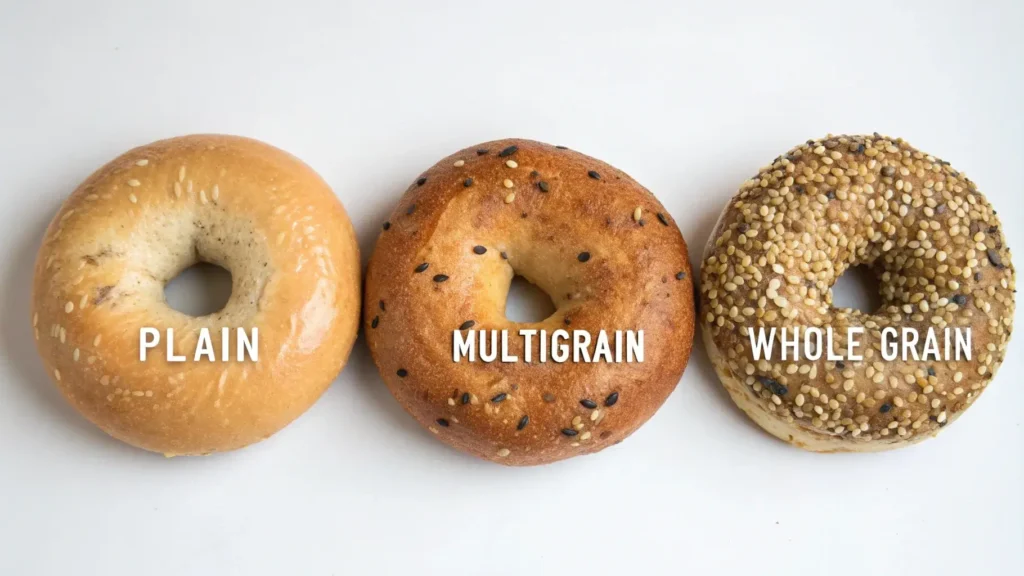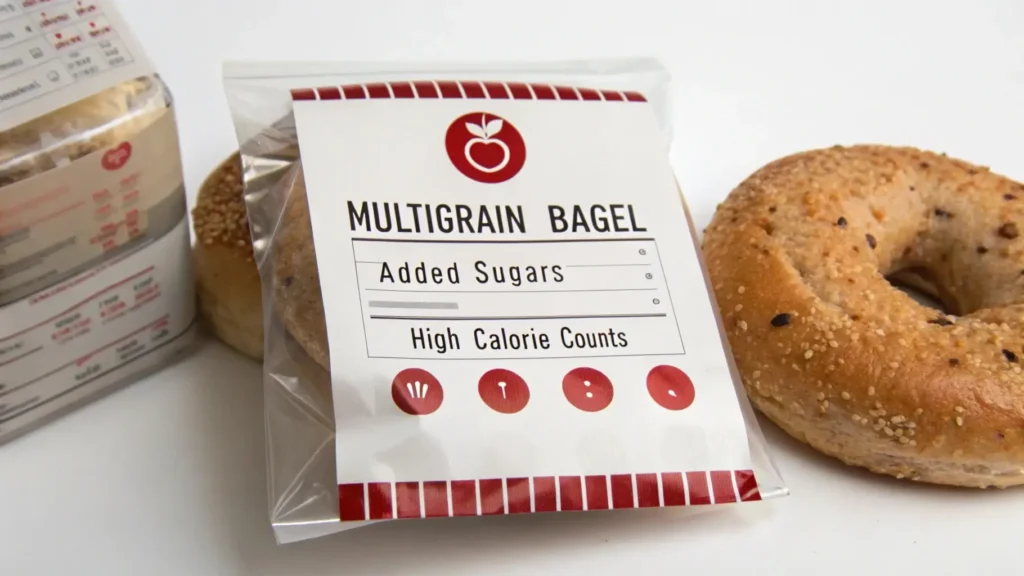Bagels are a beloved breakfast staple, but their nutritional value often sparks debate. One variety that’s been gaining attention is the multigrain bagel. With its mix of grains and seeds, it’s marketed as a healthier alternative to plain bagels. But is it really as healthy as it seems? This article dives deep into the question “Is multigrain bagel healthy?” We’ll explore its nutritional makeup, compare it to other types, and weigh the benefits and drawbacks. By the end, you’ll know exactly what to look for in your next bagel choice.
Table of contents
- Understanding Multigrain Bagels
- Nutritional Breakdown of Multigrain Bagels
- Comparing Multigrain and Other Bagel Types
- Health Benefits of Multigrain Bagels
- Potential Drawbacks of Multigrain Bagels
- Health Benefits of Multigrain Bagels
- Potential Drawbacks of Multigrain Bagels
- How to Choose a Healthy Multigrain Bagel
- FAQs About Multigrain Bagels
- Conclusion
Understanding Multigrain Bagels
What Is a Multigrain Bagel?
A multigrain bagel delivers exactly what its name suggests—a bagel made with a blend of different grains, such as oats, barley, flaxseed, and whole wheat. Unlike plain bagels, which typically rely on refined flour, multigrain bagels combine various grains to enhance both flavor and nutrition. Their grain-packed recipe gives them a hearty texture and a nutty taste.
However, not all multigrain bagels offer the same benefits. Some use whole grains, while others rely on refined grains or add extra sugars. If you’re asking “Is multigrain bagel healthy?”, the answer depends on the ingredients and their quality.
How Multigrain Bagels Are Made
TBakers start making multigrain bagels by preparing a basic bagel dough and enriching it with a mix of grains. They add the grains either in whole form, like rolled oats or seeds, or blend them into the flour. To achieve the bagel’s signature chewy texture, bakers briefly boil the dough before baking it to perfection. They often sprinkle toppings like sesame seeds, sunflower seeds, or cracked wheat on top to enhance flavor and crunch.

Understanding how these bagels are crafted gives insight into their nutritional profile. The inclusion of grains like flax or quinoa can increase their fiber and protein content, making them a potentially healthier choice than traditional bagels.
Nutritional Breakdown of Multigrain Bagels
Is Multigrain Bagel Healthy? Understanding Its Calories and Macronutrients
When asking “Is multigrain bagel healthy?”, it’s essential to start with the basics: calories and macronutrients. On average, a medium-sized multigrain bagel contains about 250–350 calories, depending on its size and ingredients. This makes it slightly more caloric than plain bagels due to the added grains and seeds.
Multigrain bagels often have a higher carbohydrate content, ranging from 50–60 grams per serving, but they typically offer more protein—about 10–15 grams—thanks to grains like quinoa or oats. Fat content is usually low unless the bagel includes seeds like flax or sunflower, which add healthy fats to the mix.
While multigrain bagels aren’t exactly low-calorie, they can provide a more balanced macronutrient profile compared to their plain counterparts.
Health Benefits: Fiber and Vitamins in Multigrain Bagels
One of the biggest perks of a multigrain bagel is its fiber content. Many multigrain bagels contain 3–5 grams of fiber per serving, which is significantly higher than plain bagels. This fiber helps support digestion and keeps you feeling full longer.
Additionally, the grains used in multigrain bagels can contribute small amounts of vitamins and minerals. For example, whole wheat offers iron and B vitamins, while flaxseed provides omega-3 fatty acids. However, not all multigrain bagels are rich in nutrients. Some may include refined grains, which strip away fiber and essential nutrients. Always check the label to ensure you’re getting the real deal.
Comparing Multigrain and Other Bagel Types
Multigrain vs. Plain Bagel: Is Multigrain Bagel Healthier?
When comparing multigrain and plain bagels, it’s clear that multigrain has some advantages. Plain bagels, typically made with refined white flour, lack fiber and contain fewer nutrients. In contrast, multigrain bagels incorporate a variety of grains, boosting their fiber and protein content.
That said, multigrain doesn’t always mean healthier. If the multigrain bagel is made with refined grains or loaded with sugars, it might not be much better than a plain bagel. To truly answer the question “Is multigrain bagel healthy?”, it’s crucial to examine the ingredient list.
Whole Grain vs. Multigrain Bagels: Which is Better for Your Health?
While multigrain and whole grain sound similar, they’re not the same. A whole grain bagel uses flour made from the entire grain kernel, which retains all its nutrients and fiber. On the other hand, a multigrain bagel simply includes multiple types of grains, but they’re not always whole grains.
Whole grain bagels are often the healthier option, but multigrain bagels still hold their own, especially if they include whole grains in the mix. For the healthiest choice, look for labels specifying whole grains as a primary ingredient.

Health Benefits of Multigrain Bagels
Why Is Multigrain Bagel Healthy? Fiber and Energy Benefits
One of the standout benefits of multigrain bagels is their high fiber content. Grains like oats, flaxseed, and whole wheat, commonly used in these bagels, are rich in dietary fiber. Fiber supports digestion by promoting regular bowel movements and preventing constipation. It also contributes to gut health by feeding good bacteria in the digestive tract. For those wondering “Is multigrain bagel healthy?”, this fiber boost is a significant advantage.
Multigrain Bagels for a Balanced Diet: Key Reasons to Choose Them
Multigrain bagels are packed with complex carbohydrates, which provide a steady energy supply throughout the day. Unlike refined carbs that cause quick sugar spikes and crashes, the grains in these bagels release energy gradually. Additionally, the combination of fiber and protein helps you feel full longer, reducing the likelihood of mid-morning hunger pangs.
For more breakfast inspiration, check out Kamala Recipes’ multigrain bagel guide, which offers creative ways to enjoy these nutritious bagels.
Potential Drawbacks of Multigrain Bagels
Hidden Sugars and Additives
While multigrain bagels sound healthy, not all are created equal. Store-bought options often include added sugars and preservatives to enhance flavor and shelf life. These additives can undermine the nutritional benefits of the grains, making the bagel less healthy than it appears. Always read the label carefully to spot hidden sugars and unnecessary ingredients.
High-Calorie Content for Weight Management
Even though multigrain bagels are a better option than plain ones, they’re still calorie-dense. A single bagel can contain anywhere from 250 to 350 calories, not including spreads or toppings. For those managing their weight, this calorie count can add up quickly, especially if the bagel is paired with cream cheese or butter.
To enjoy multigrain bagels healthily, consider adding low-calorie spreads like hummus or avocado. If you’d like more healthy breakfast ideas, explore Kamala Recipes’ collection of wholesome meals.
Health Benefits of Multigrain Bagels
Rich in Fiber for Digestion
One of the standout benefits of multigrain bagels is their high fiber content. Grains like oats, flaxseed, and whole wheat, commonly used in these bagels, are rich in dietary fiber. Fiber supports digestion by promoting regular bowel movements and preventing constipation. It also contributes to gut health by feeding good bacteria in the digestive tract. For those wondering “Is multigrain bagel healthy?”, this fiber boost is a significant advantage.
Source of Energy and Satiety
Multigrain bagels are packed with complex carbohydrates, which provide a steady energy supply throughout the day. Unlike refined carbs that cause quick sugar spikes and crashes, the grains in these bagels release energy gradually. Additionally, the combination of fiber and protein helps you feel full longer, reducing the likelihood of mid-morning hunger pangs.
For more breakfast inspiration, check out Kamala Recipes’ multigrain bagel guide, which offers creative ways to enjoy these nutritious bagels.
Potential Drawbacks of Multigrain Bagels
Is Multigrain Bagel Healthy for Weight Loss? Hidden Sugars and Calories
While multigrain bagels sound healthy, not all are created equal. Store-bought options often include added sugars and preservatives to enhance flavor and shelf life. These additives can undermine the nutritional benefits of the grains, making the bagel less healthy than it appears. Always read the label carefully to spot hidden sugars and unnecessary ingredients.
Are Multigrain Bagels Always a Healthy Choice? What to Avoid
Even though multigrain bagels are a better option than plain ones, they’re still calorie-dense. A single bagel can contain anywhere from 250 to 350 calories, not including spreads or toppings. For those managing their weight, this calorie count can add up quickly, especially if the bagel is paired with cream cheese or butter.

To enjoy multigrain bagels healthily, consider adding low-calorie spreads like hummus or avocado. If you’d like more healthy breakfast ideas, explore Kamala Recipes’ collection of wholesome meals.
How to Choose a Healthy Multigrain Bagel
Is Multigrain Bagel Healthy? Ingredients to Look For
When asking “Is multigrain bagel healthy?”, the answer often lies in the ingredient list. Not all multigrain bagels are equally nutritious, as some use refined grains or add fillers like sugar and preservatives. Look for bagels made with whole grains as the first ingredient. These provide fiber, vitamins, and minerals essential for a balanced diet.
Additionally, avoid bagels with added sugars listed near the top of the ingredients. Instead, choose varieties with natural grains like oats, quinoa, and flaxseed, which add nutritional value without extra calories. Checking for short, clean ingredient lists can help you make a healthier choice.
Best Multigrain Bagels for a Healthy Breakfast
If you’re buying bagels from popular chains, it’s helpful to know their nutritional profiles. For example, Dunkin’s multigrain bagel offers a decent amount of fiber and protein, making it a good choice for those seeking a satisfying breakfast. Similarly, Starbucks’ multigrain bagel is packed with hearty grains, though it’s slightly higher in calories.
To enjoy a healthy multigrain bagel, pair it with toppings like avocado, low-fat cream cheese, or a spread of almond butter. This combination balances flavor and nutrition without overloading on calories.
FAQs About Multigrain Bagels
What is the Healthiest Bagel?
The healthiest bagel is one made with whole grains and minimal added sugars or preservatives. Whole grain bagels are rich in fiber, which supports digestion and helps you feel full longer. Additionally, bagels with seeds like flax or chia provide healthy fats and extra nutrients. Multigrain and whole grain varieties are often better choices than plain or refined white bagels.
Is a Whole Grain Bagel Healthy?
Yes, whole grain bagels are a healthy option. They are made from flour that retains the entire grain kernel, including the bran, germ, and endosperm. This means they’re packed with fiber, vitamins, and minerals. Whole grain bagels also have a lower glycemic index compared to refined bagels, making them a great choice for sustained energy and balanced blood sugar levels.
Is Multigrain Bread Healthy for Diet?
Multigrain bread can be healthy for your diet, but it depends on the ingredients. Bread labeled “multigrain” simply means it contains multiple types of grains, but they’re not always whole grains. To ensure it’s a healthy choice, look for multigrain bread with whole grains listed as the first ingredient and without added sugars or fillers. Its fiber content makes it a good option for weight management when eaten in moderation.
Do Multigrain Bagels Have Sugar?
Yes, many multigrain bagels contain added sugars to enhance flavor and improve texture. However, the amount of sugar varies by brand and recipe. It’s important to check the nutrition label for hidden sugars, especially if you’re aiming for a low-sugar diet. Homemade or carefully selected store-bought options can help you avoid unnecessary sugar intake.
Conclusion
In conclusion, the answer to “Is multigrain bagel healthy?” largely depends on its ingredients and how it fits into your overall diet. Multigrain bagels can be a nutritious choice when made with whole grains, offering fiber, protein, and essential nutrients. They provide sustained energy and can be a great addition to a balanced breakfast.
However, it’s important to watch out for hidden sugars, additives, and high calorie counts in store-bought options. Always check labels and opt for varieties with clean, simple ingredients. If you’re looking for the healthiest option, homemade multigrain bagels give you complete control over what goes into your food.
Whether you enjoy them with avocado, low-fat cream cheese, or as part of a protein-packed meal, multigrain bagels can be a delicious and wholesome choice when consumed in moderation. With the right balance, they’re a satisfying way to start your day!


